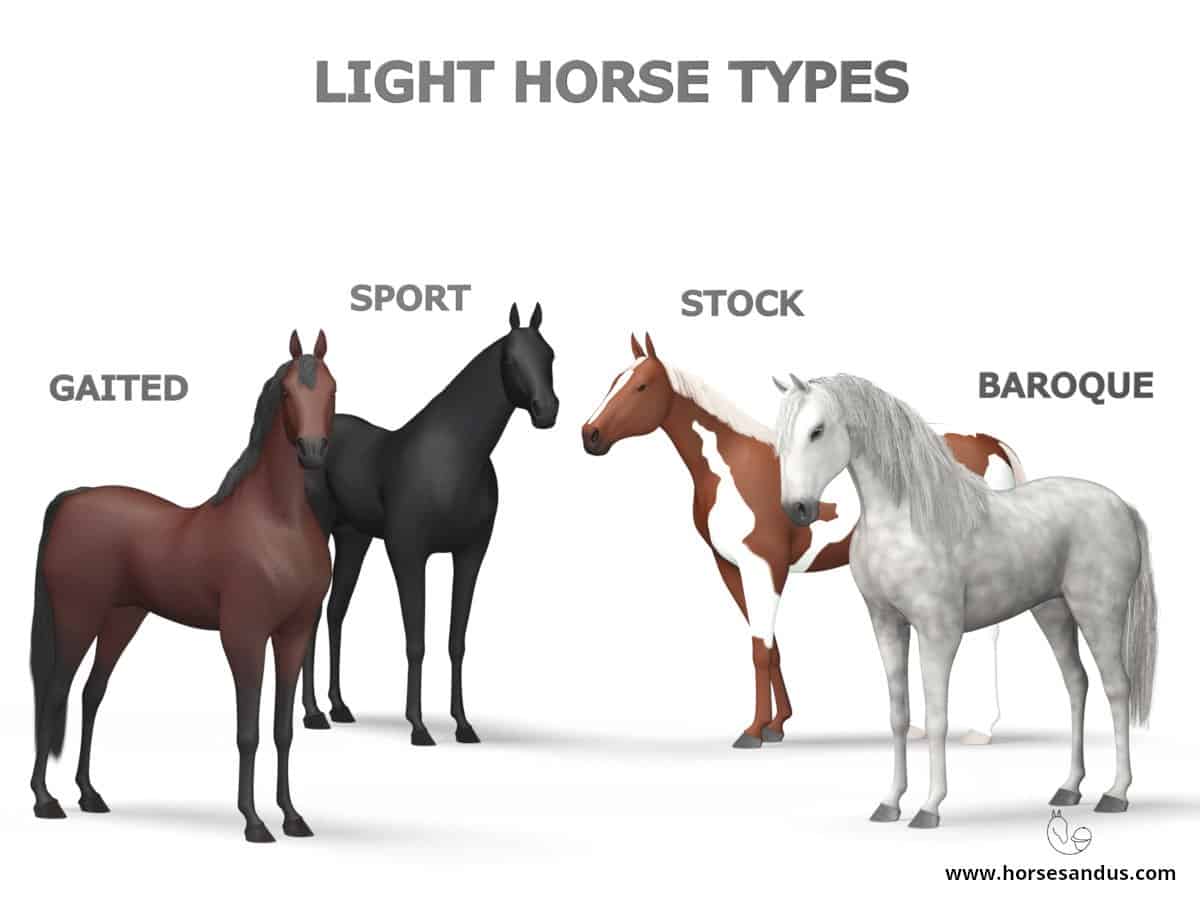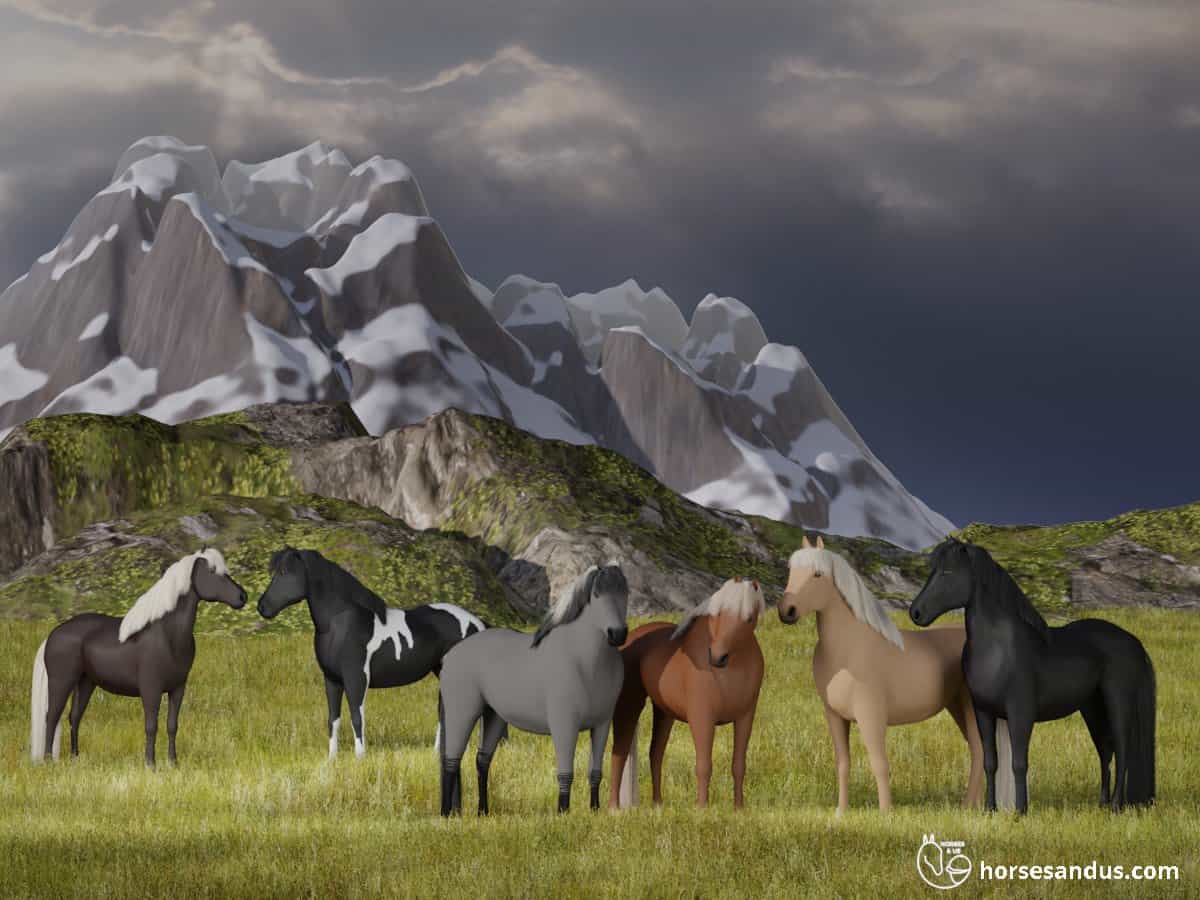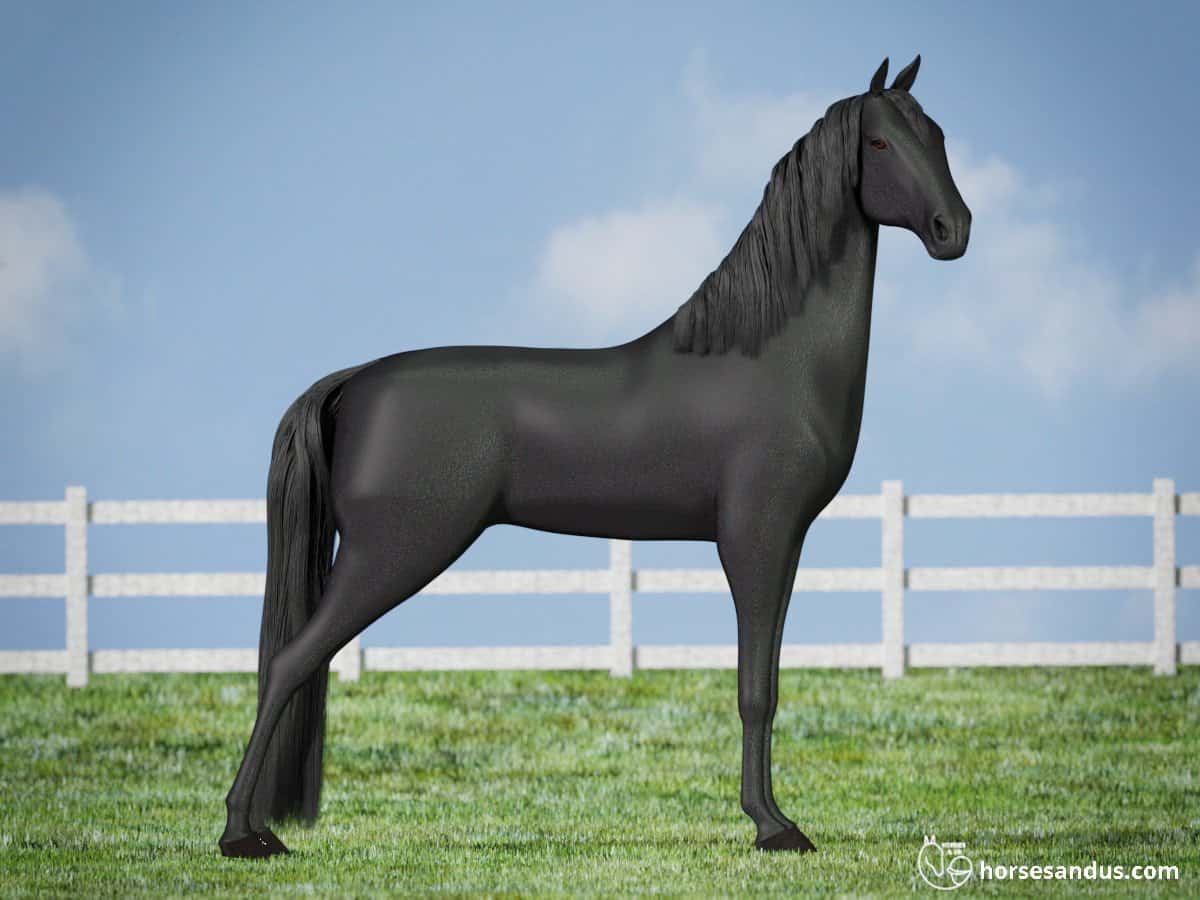Horses can be grouped into 3 types – Heavy, Light, or Pony – according to their weight, body build, and height. Heavy horses are the biggest and strongest. Light horses are agile and have a conformation that allows them to be ridden. Ponies are the smallest, with a stocky build and short legs.
In this article we will explain the basic characteristics and uses of each horse type.
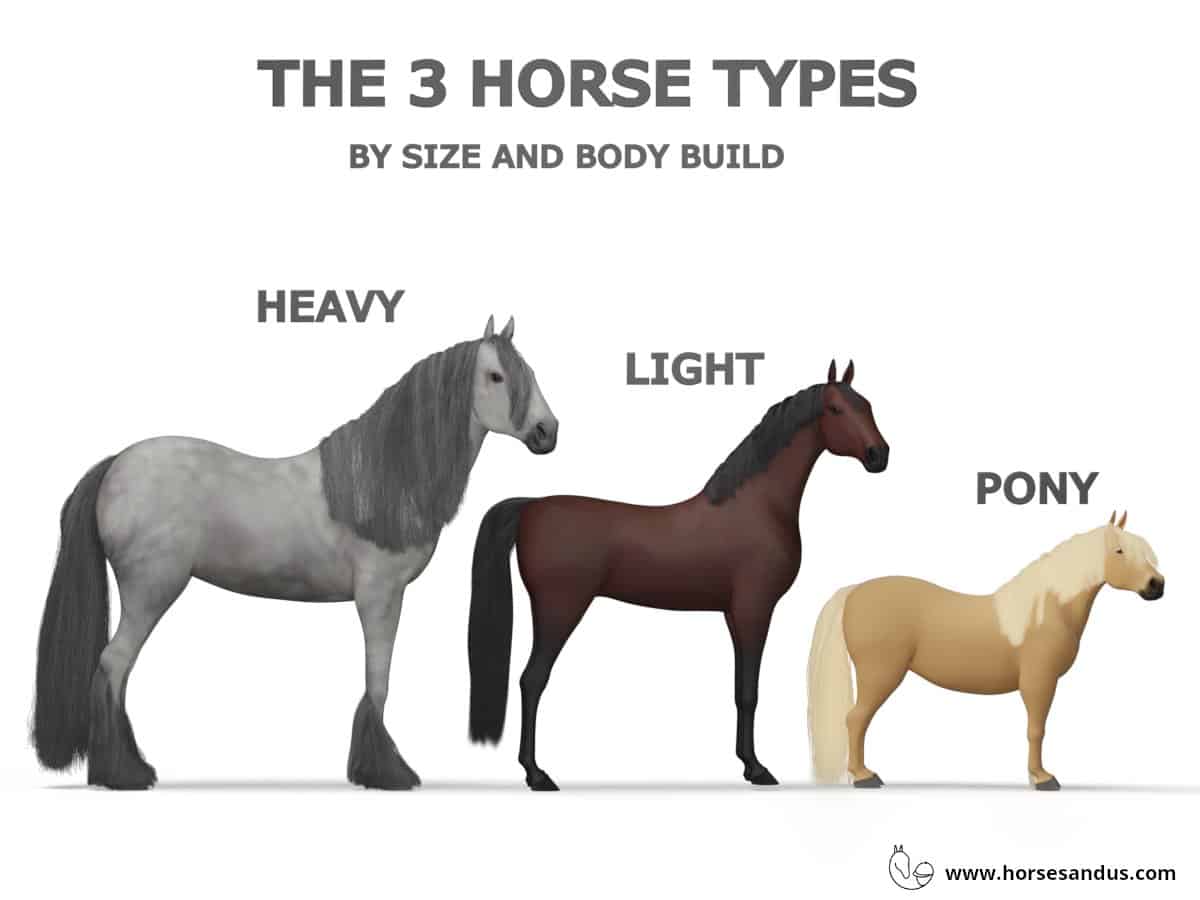
Heavy Horse
A Heavy Horse, also called a Draft Horse or a Draught Horse (in the UK), is a heavy, muscular horse traditionally used for plowing and pulling heavy loads.
They are intelligent and trainable, making them easy to handle.
Heavy horses are often referred to as “gentle giants” due to their docile temperament, which is why they are considered cold-blooded.
Heavy Horse Characteristics
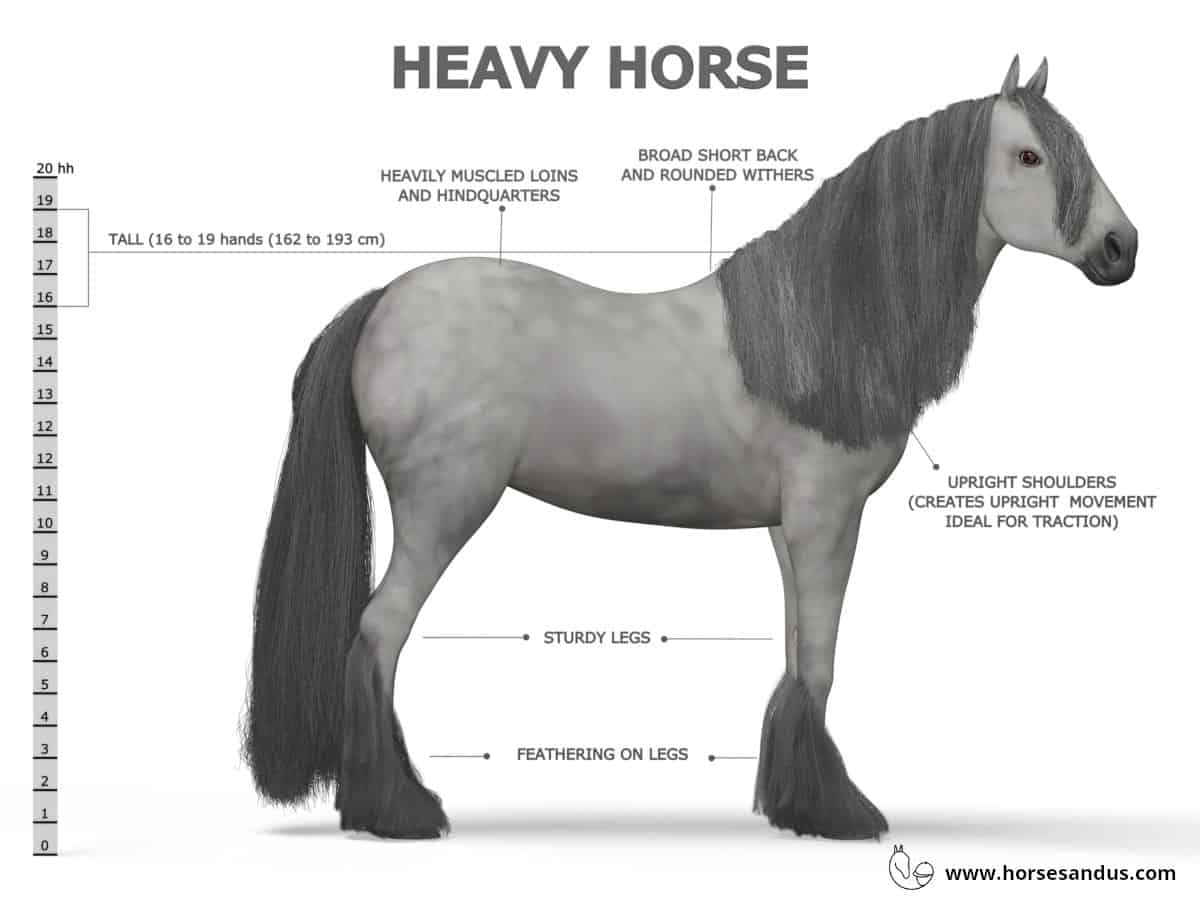
Heavy Horses have the following distinguishing characteristics :
Heavy Horse Breeds
A number of horse breeds are classified as draft.
The most popular heavy horses and countries of origin are:
- Shire (England)
- Suffolk (England)
- Clydesdale (Scotland)
- Percheron (France)
- Boulonnais (France)
- Ardennais (France/Belgium)
- Belgian or Brabant (Belgium)
- Noriker (Austria)
- American Cream Draft (USA)
All Heavy Horses are Drafts but not all Drafts are Heavy horses
Heavy horses are also commonly called draft horses, because they all have the draft characteristics. In fact these names are used interchangeably when referring to these horses.
However not all horses with draft characteristics are heavy horses.
There are Light Horses that can also be classified as draft, such as:
- Friesian (Netherlands)
- Freiberger (Switzerland)
- Irish Draught (Ireland)
Additionally there are draft ponies like for instance:
- Haflinger (Austria)
- Fjord (Norway)
What are Heavy Horses Used For?
For many years heavy horses have been used to perform hard work such as plowing, logging, mining, and pulling heavy loads.
Today they are mostly used for driving, showing, and pulling competitions.
However, in some locations in the world, they are still used in small farms and forestry where mechanized equipment cannot be used.
Also, with the emerging trend of fossil fuel-free agriculture, some farmers are using heavy horses to perform their farming activities. An interesting article on this can be found here, and an example of a horse-powered farm can be seen here.
There are some interesting books you can read about this subject which can be found in amazon:
The New Horse Powered Farm and Horse-Powered Farming for the 21st Century
Can Heavy Horses be Ridden?
Yes, heavy horses can be ridden. Despite their size and power, they are intelligent and docile and are therefore trainable and trustworthy. Being cold-blooded, you may think they are slow and require a strong leg. However, they are perfectly capable of galloping without the need for spurs. They actually make an excellent trail mount.
Heavy horses can be seen in fox-hunting and even competing in dressage and eventing rings. But, due to their body build, they can´t be expected to perform in the top levels.
A Heavy horse will require a saddle that is designed specifically for its size and wide back. But because heavy horses are being ridden more often than ever, these types of saddles are being manufactured and can be easily found.
History of the Heavy Horses
We will now look back in time to see the origins of the Heavy horse and what it was used for.
Origin of Heavy Horses
The origin of the Heavy horse is not clearly known, but some hippologists believe its ancestor was from the cold plains of Northern Europe, while others think it was from the forests.
In any case, it is believed to originate from the wild Nordic pony, which adapted to survive in wet and cold climates and could thrive on the coarse feed of poor nutritional value. Although much smaller, its physical characteristics (draft type of body build) are similar to the Heavy horse.
The selective breeding over thousands of years has led to the large, strong, and gentle Heavy horses we know today. They were bred for size, strength, and gentle temperament, which were ideal traits for hard labor.
Uses of Heavy Horses in History
Heavy horses were the most versatile work animal and played a key role in warfare, agriculture, mining, logging, and transportation.
Only a century ago, Heavy horses were almost everywhere, providing a dependable and renewable power source. But with the development of mechanized equipment, they are no longer needed for heavy labor and have almost disappeared from the streets and farms.
Nevertheless, the modern Heavy horse is reappearing, now as a pleasure horse, and is commonly seen in trail rides, shows, parades, and competitions across the world.
Light Horse
A light horse is the type of horse with a conformation suitable for riding or driving (pulling buggies). As the name suggests, they are light weighted and therefore capable of more action and speed than draft horses.
These horses can also be called hot-blooded due to their temperament. Additionally, some light horses can also be considered warm-blooded if they belong to a breed that has cold-blooded horses in its ancestry.
Light Horse Characteristics
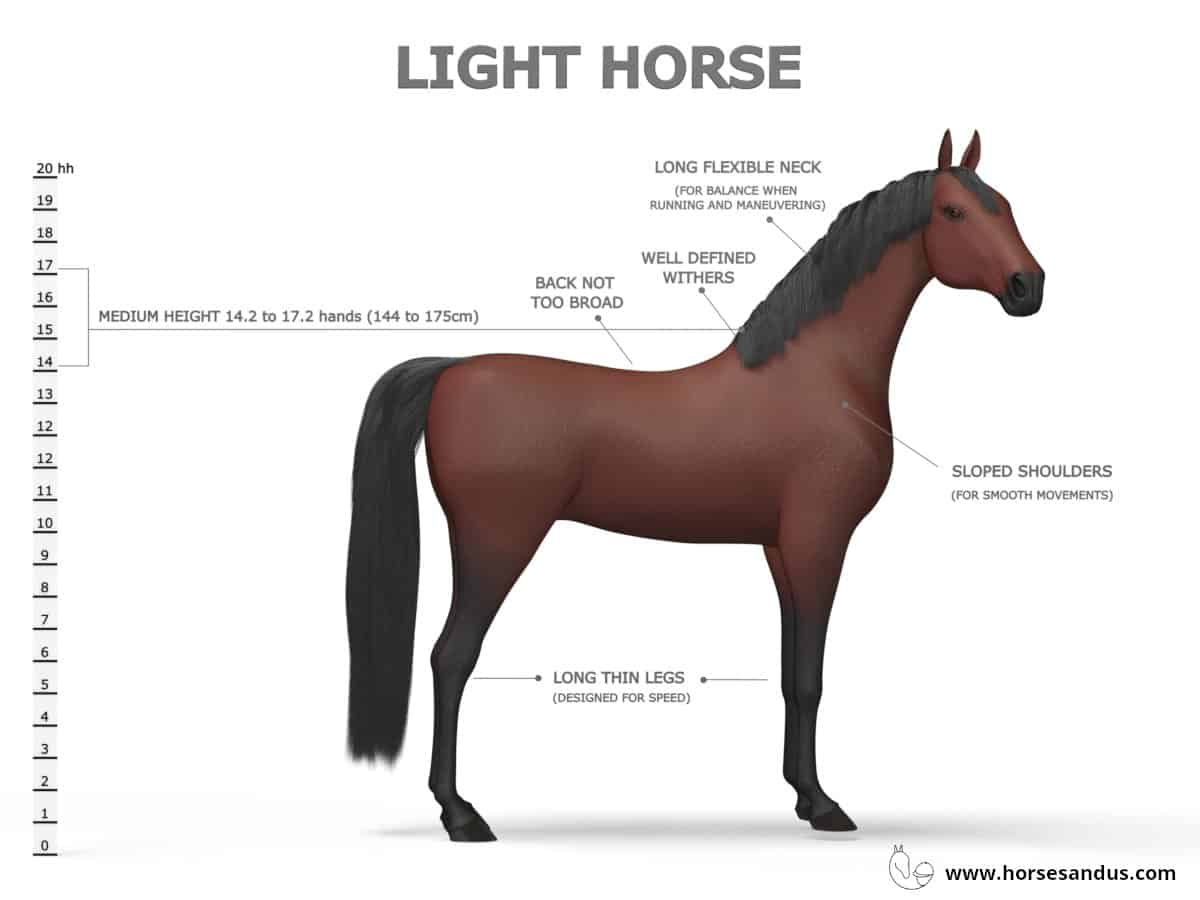
Light Horses have the following distinguishing characteristics :
Types of Light Horses
Although light horses have the characteristics mentioned above, there will be variations depending on the type of light horse.
The different types of light horses include Stock, Sport, Baroque, and Gaited. If you would like to learn more about these different types, read our article about the 4 Types Of Light Horses.
Light Horse Breeds
There are a wide range of breeds that can be grouped into the light horse type.
The list is huge but below are some examples of the most well known breeds and countries of origin:
Europe
- Swedish warmblood (Sweden)
- Dannish warmblood (Denmark)
- Dutch warmblood (Netherlands)
- Belgian warmblood (Belgium)
- Trakehner (Poland)
- Holsteiner (Germany)
- Oldenburg (Germany)
- Lipizzaner (Austria)
- Selle Francais (France)
- Camargue (France)
- Thoroughbred (England)
- Cleveland Bay (England)
- Sardinian (Italy)
- Andalusian (Spain)
- Lusitano (Portugal)
America
- American Saddlebred (USA)
- Appaloosa (USA)
- Morgan (USA)
- Mustang (USA)
- Paint Horse (USA) … link to my article
- Quarter Horse (USA)
- Tennessee Walking Horse(USA)
- Criollo (Argentina)
- Peruvian Paso (Peru)
Africa
- Barb (Morocco)
Asia
- Arabian (Arabian Peninsula)
- Akhal-Teke (Turkmenistan)
- Orlov Trotter (Russia)
Australia
- Australian Stock Horse (Australia)
What are Light Horses Used For?
Light horses are suitable for riding and driving. They are used across a wide range of disciplines, a few of which are:
Show-Jumping
In show-jumping, the riders guide horses over a course of obstacles and the winner is the one that completes most obstacles without faults in the fastest time.
Racing
In racing, the horses can be ridden or driven over a certain distance, and the winner is the fastest one that completes the course first. There are different types of horse racing, such as flat racing, endurance racing, jump racing, or harness racing.
Dressage
It is a kind of ballet on horseback. It combines power, beauty, and precision. In dressage competitions, the riders must execute certain predefined movements and are judged on the accuracy, suppleness, and overall balance of horse and rider.
Eventing
It is an equestrian triathlon consisting of Dressage, cross country, and show-jumping over three days. The winner is the one that has the highest score overall.
Barrel Racing
It is a rodeo event where the rider needs to complete a clover leaf pattern around 3 preset barrels. The winner is the one who completes the pattern in the fastest time
Polo Riding
A team sport where players score by driving a small ball into the opposing teams+s goal using a long-handled mallet. The winner is the team that has the highest score.
Trail Riding
It is an outdoor activity where horses are ridden on natural trails. Trail rides can be an informal activity done by one person or a group of people. It can also be a competitive event, which tests the trail riding ability of the horse and rider.
History of Light Horses
All Light horses have their most remote origins in the Arabian horse from the Middle East and the Barb Horse from North Africa.
Other breeds of Heavy horses and Ponies were added to the Light horse breeds during their evolution, leading to the huge diversity of Light horse breeds that we know today.
Pony
Ponies are small (usually below 14.2 hh/148cm). These are the smallest of the 3 types of horses (Heavy, Light, Pony).
However, not every small horse is considered a pony. The definition can become blurry because height is not the only characteristic that defines a pony.
Ponies have other defining characteristics, like, for example, a stocky build. Also, miniatures, although very small, are not considered ponies but rather horses.
Tradition Plays a Role in the Definition of a Pony
Tradition also plays a role in defining whether an animal is a pony or a horse.
The Two Main Definitions of a Pony
So to clear things up a bit we should understand the two main definitions for a pony:
1- A Pony is a horse that is under 14.2hh/148cm, regardless of its breed.
This definition is mainly made by the International Federation for Equestrian Sports to determine the height cutoff for equestrian competitions.
2. A pony is a small horse usually under 14.2hh/148cm with a specific conformation and temperament and belongs to a particular pony breed.
This definition is made by the different equine breed registries.
Pony Characteristics
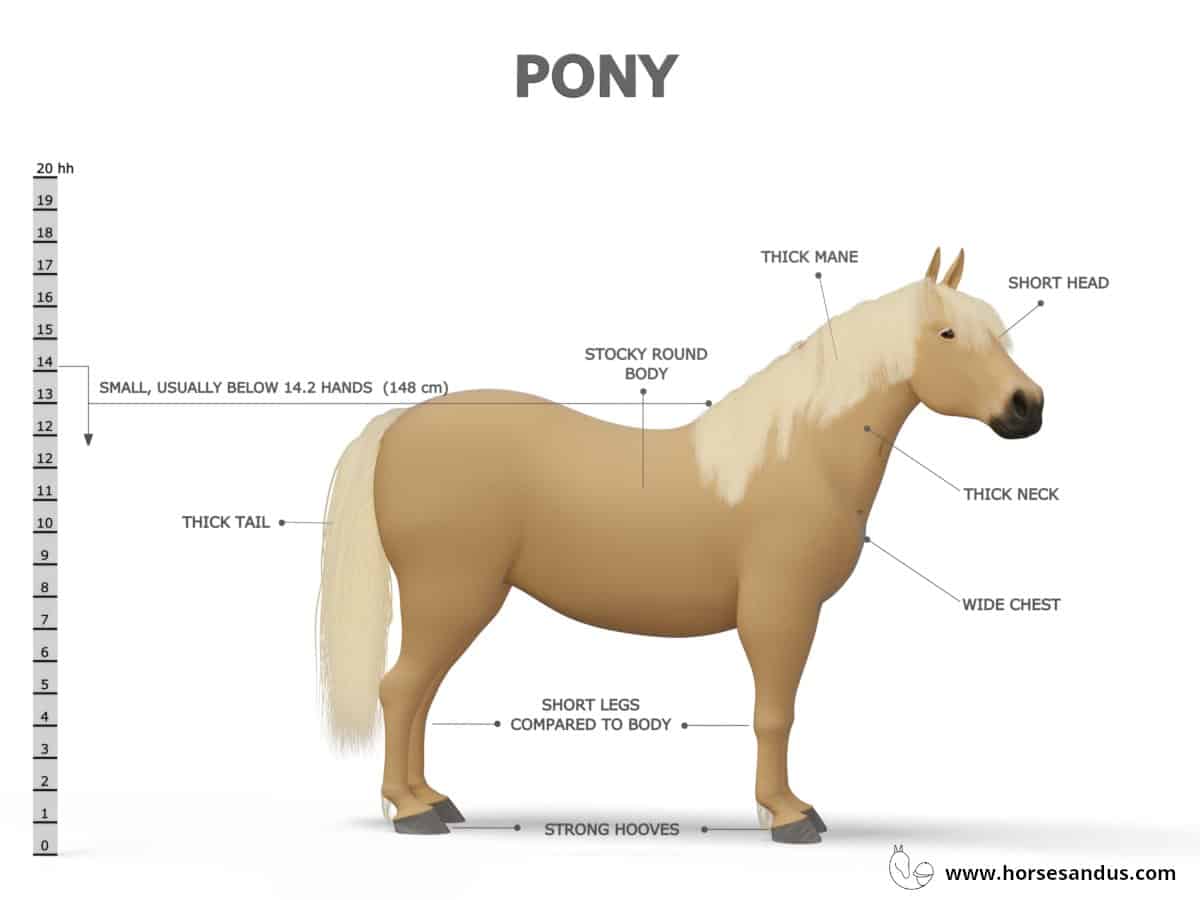
Pony Breeds
There are many pony breeds from around the world. We will list just a few such as:
- Gotland (Sweden)
- Haflinger (Austria)
- Shetland (Scotland)
- Highland (Scotland)
- Exmoor (England)
- New Forest Pony (England)
- Connemara (Ireland)
- Welsh Pony (Wales)
- Landais (France)
- Konik (Poland)
- Bashkir (Russia)
- Rocky Mountain Pony (USA)
- Falabella (Argentina)
- Australian Pony (Australia)
What are Ponies Used For?
Ponies are very versatile and have many different uses such as riding, driving and working.
Riding
They are commonly used for children to ride and are seen participating in various equestrian disciplines, such as Show Jumping, Eventing, Dressage, and trail riding.
Driving
Some pony breeds such as the Hackney Pony are normally used for driving.
Working
Most of the UKs native pony breeds were developed for work such as the Fell Pony or the Dales.
History of Ponies
Ponies were originally developed as working horses to help humans. In farm work, for pulling loads in coal mines and forestry, and for transportation. They are quite strong for their size and very robust, being able to survive in harsh environments.
Later on, ponies were crossed with light horses such as the Arabian, which made them also suitable for riding.
Is a Pony a Baby Horse?
Some people may think that a pony is a baby horse because of its small size. But this is not correct.
A baby horse has less than one year and is called a foal. It will grow up to be an adult horse. Baby ponies under one year are also called foals and will grow up to become an adult pony. You can learn about baby horses in our article explaining what a baby horse is called.
A Pony is called a pony during its entire lifetime. Regardless of whether it is a baby or an adult.
Physically they are very different also. The Infographic compares a pony with a baby horse (foal)
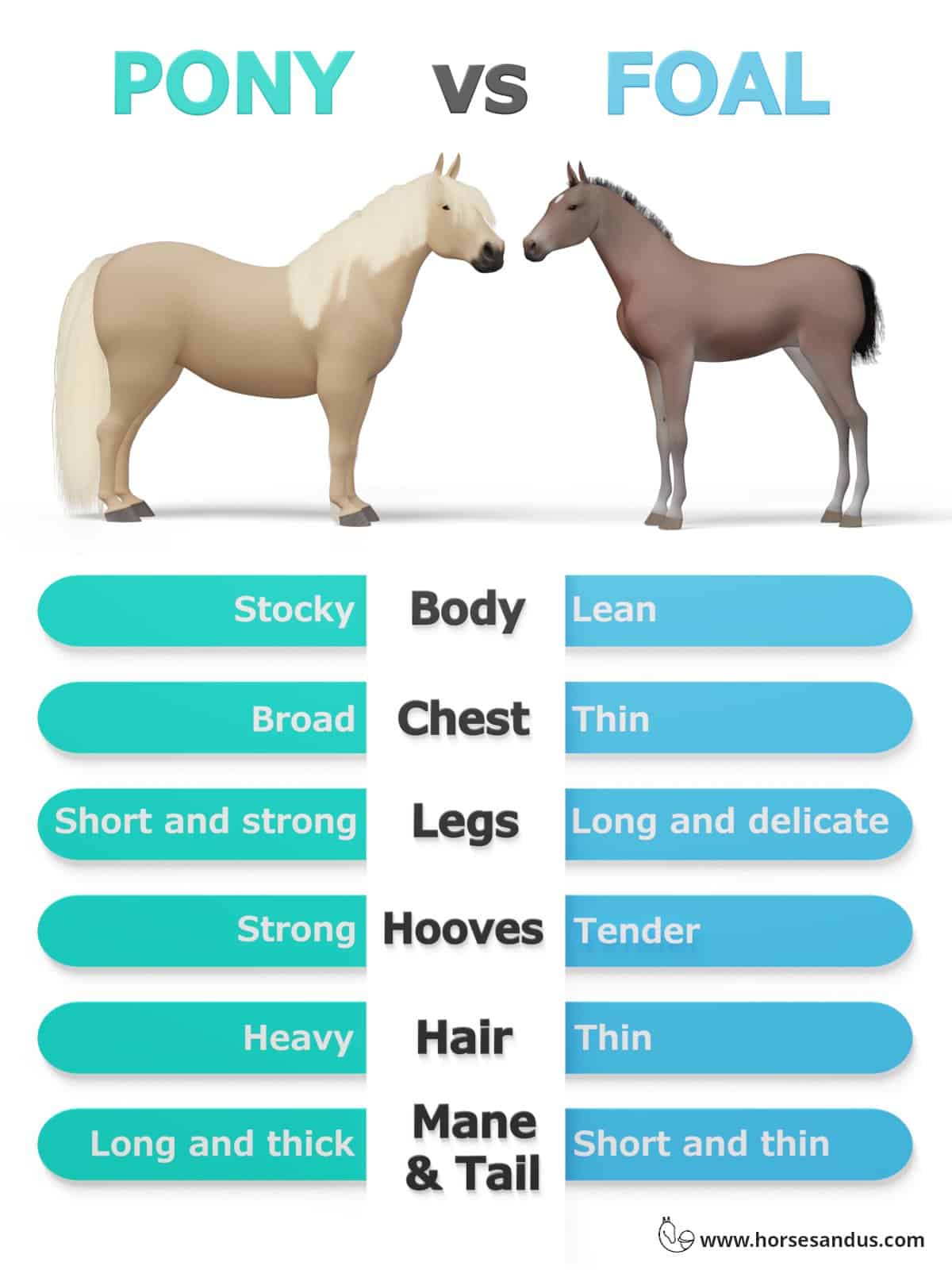
So to conclude – A pony is definitely not a baby horse.
